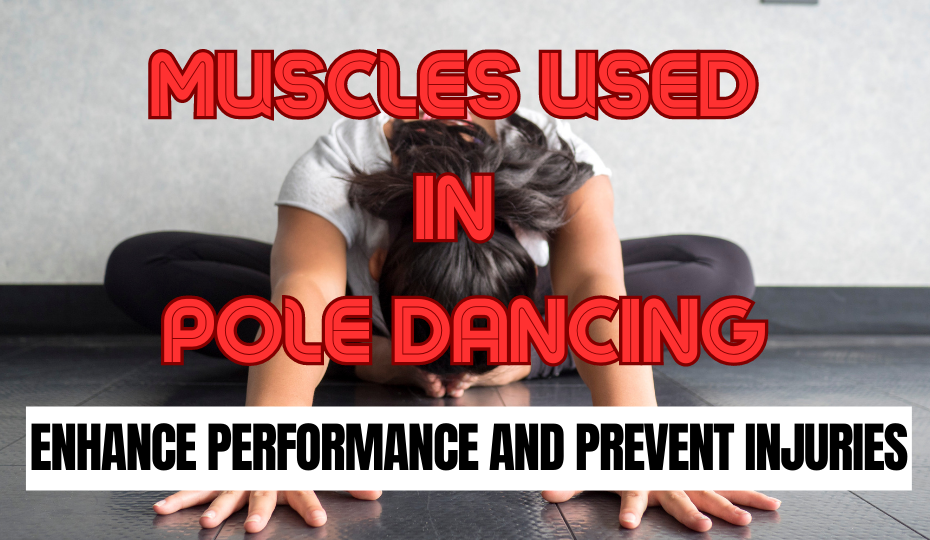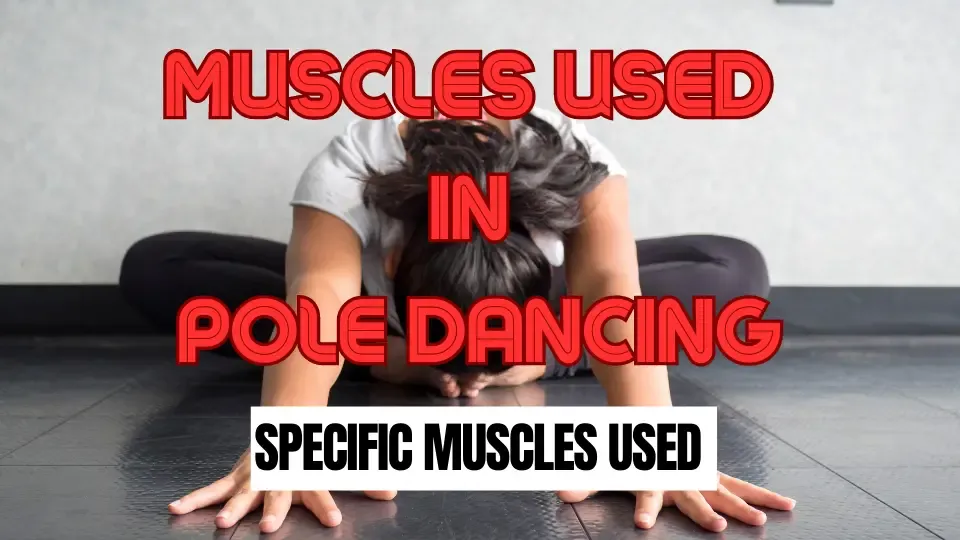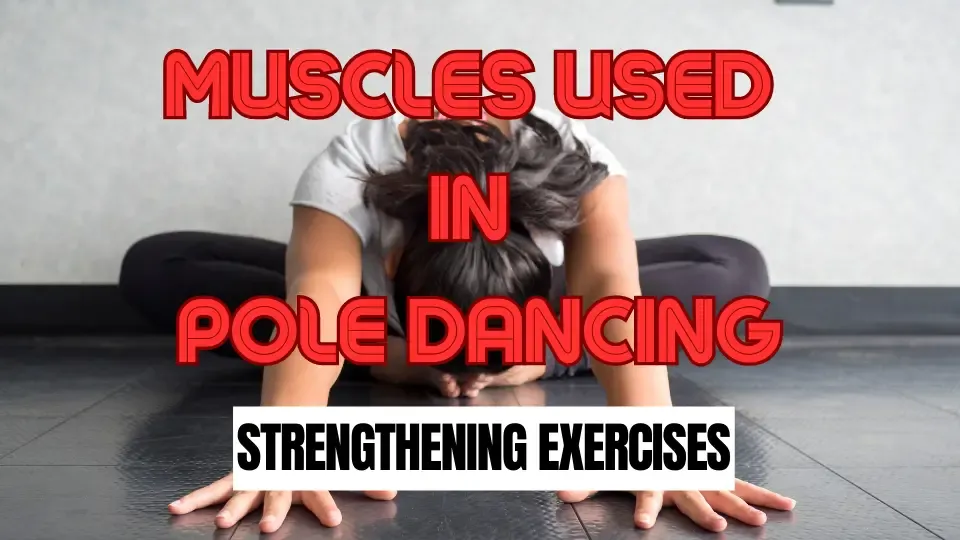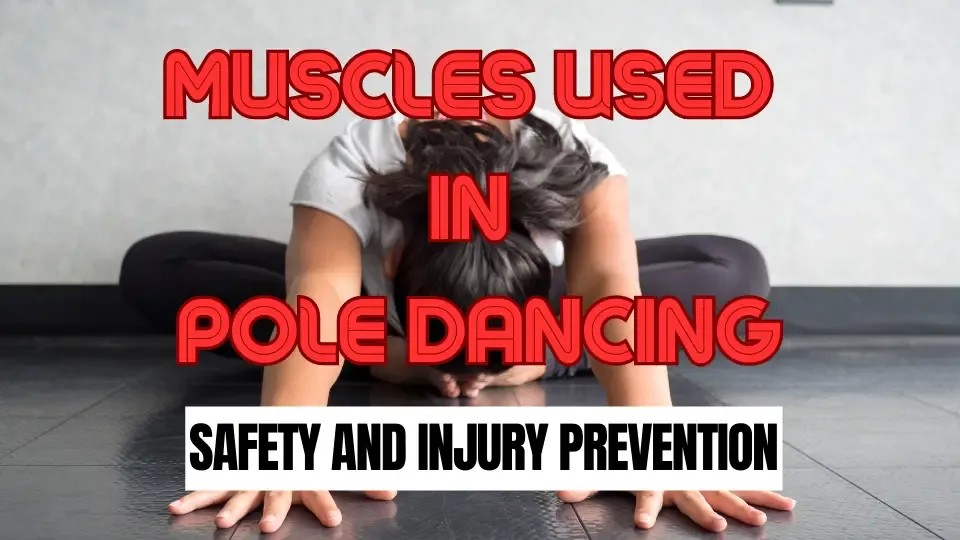· Home Pole Dance · Pole Dancing · 15 min read
Muscles Used in Pole Dancing: A Comprehensive Guide to Enhancing Performance and Preventing Injuries
As someone who has tried various workouts in my quest for fitness, I was pleasantly surprised by the intensity of pole dancing. What I initially perceived as just a dance form soon revealed itself as an all-round fitness regimen.

As someone who has tried various workouts in my quest for fitness, I was pleasantly surprised by the intensity of pole dancing. What I initially perceived as just a dance form soon revealed itself as an all-round fitness regimen.
Whether you are performing spins, tricks, or transitions, pole dancing constantly engages and challenges various muscle groups. This is not just a dance or acrobatic skill; it’s a comprehensive fitness routine, providing both cardio and strength training.
The first time I tried to hoist myself onto the pole, I felt my core muscles ignite. I quickly realized that the abs, obliques, and lower back are continuously at work during pole dancing. Even simple moves require a strong core to maintain balance and control.
Similarly, my upper body was put to the test. From my arms and shoulders to my back, every lift, hold, and spin demanded muscle strength, control, and endurance. But that’s not all. Pole dancing also engages the lower body. Your legs, glutes, and hips are crucial for providing stability, executing specific moves, and adding grace to your performance.
In essence, pole dancing is an underestimated form of fitness and wellness, engaging your entire body and mind, making it an exciting and unique way to stay fit and strong. And as we delve deeper into this guide, we’ll examine the specific muscles used in pole dancing and how they contribute to your fitness journey.
Also read Pole Dance Instructor Insurance
Key Takeaways
- 💪 Pole dancing presents a full-body workout, engaging core, upper, and lower body muscles, thereby improving strength, flexibility, and overall fitness.
- 🏋️ Incorporating strength-building exercises like planks, push-ups, squats and lunges into your fitness regimen can help prepare your muscles for pole dancing.
- 👍 Prioritize safety in pole dancing by thoroughly warming up before sessions, cooling down afterwards and using proper techniques when performing moves to prevent injuries.
- 💡 Enhance your pole dancing performance by consciously engaging the relevant muscles in each move and gradually progressing in developing pole dancing skills.
- 🗺️ Choose pole dancing classes or workshops aligned with your skill level and goals for effective learning and improvement. Consistency, patience, and enjoying the process are key to mastering pole dancing.
Also read How To Become A Pole Dance Instructor
Unraveling the Specific Muscles Used in Pole Dancing

When I first embraced the rhythm of pole dancing, I was astonished by the sheer variety of muscles used in pole dancing. Initially, you might assume it’s solely about upper body strength, but that barely scratches the surface. In reality, pole dancing is a comprehensive workout that involves an array of muscle groups, from your core to your upper and lower body. Today, I’d like to take you through the fascinating world of muscles used in pole dancing and explain how each one contributes to a powerful performance.
Muscles Used in Pole Dancing: The Core
A robust core is at the heart of a solid pole dance routine, and it’s one of the crucial areas where the muscles used in pole dancing come into play. Your core muscles, including the rectus abdominis, obliques, and erector spinae, are fundamental to almost every pole move. Whether it’s executing a simple pole sit or mastering more complex inversions, your core is the sturdy anchor that keeps you stable and balanced.
As I perform a basic spin, the muscles used in pole dancing really shine, especially my core muscles, working hard to maintain my body position as I gracefully twirl around the pole. During an inversion, my core propels my hips upwards and keeps me stable in the inverted position. So, if you’re exploring the world of muscles used in pole dancing for fitness and wellness, enhancing your core strength can significantly boost your performance.
Muscles Used in Pole Dancing: The Upper Body
Moving on, the upper body muscles used in pole dancing provide a formidable workout. Your arms, shoulders, and back muscles, including the biceps, triceps, deltoids, latissimus dorsi, and rhomboids, are all integral to the art of pole dancing.
For instance, when performing a pole pull-up, the muscles used in pole dancing, particularly my biceps, triceps, and latissimus dorsi, are in full swing, lifting my body off the ground. As I hold a static pose, it’s my shoulder and back muscles, some of the key muscles used in pole dancing, that keep me up there. The upper body workout in pole dancing is intense but rewarding. Feeling the strength in your arms and back as you master new moves is truly empowering.
Muscles Used in Pole Dancing: The Lower Body
Finally, let’s not overlook the importance of the lower body muscles used in pole dancing. Although it might not seem as obvious, your legs, glutes, and even your feet play a significant role in pole dance moves. Key lower body muscles include the quadriceps, hamstrings, glutes, and calves.
In a climb, another technique that showcases the muscles used in pole dancing, my legs become the powerhouse propelling me upwards. The quadriceps and hamstrings are doing most of the work. In a pole sit, the inner thighs (also among the crucial muscles used in pole dancing) are engaged to keep me securely on the pole. Even my calf muscles are constantly working, whether I’m pointing my toes for a graceful line or pushing off the ground for a dynamic spin.
Understanding the variety of muscles used in pole dancing is critical to improving your performance and preventing injuries. It also helps you appreciate the strength and skill that pole dancing requires, making each move an accomplishment to be proud of. Plus, realizing how many muscles you’re working can be a great motivation. After all, pole dancing is not just a dance or a sport—it’s a journey of physical empowerment and self-expression.
Also read Best Freestanding Dance Poles
Strengthening Exercises for Muscles Used in Pole Dancing

Core Strengthening Exercises
Discover how these exercises work the various muscles used in pole dancing, primarily engaging your midsection.
In my pole dancing journey, I’ve learned that a strong core is not just about a flat stomach. It’s about having the power, stability, and endurance in your abdominals, obliques, and lower back to perform those awe-inspiring moves. The muscles used in pole dancing demand a lot from your core, so let’s discuss some strengthening exercises that I’ve found to be incredibly beneficial.
One of my favorites is the plank. A full-body exercise, planks primarily strengthen the core, engaging the transverse abdominis, rectus abdominis, and the obliques. Incorporate variations such as side planks or plank jacks to challenge your body differently.
Another excellent core strengthener is the Russian twist. It directly targets the obliques and the muscles of the lower back. Remember, keeping a controlled movement is the key to getting the most out of this exercise.
Upper Body Strengthening Exercises
Embrace the dynamic world of pole dancing as we delve into the intricate topic of the muscles used in pole dancing, with a special focus on the upper body.
Pole dancing also requires significant upper body strength. Climbs, inversions, and holds all demand power from your arms, shoulders, and back. Let’s go through some of my go-to upper body strengthening exercises.
Firstly, push-ups are an all-rounder. They work your chest, triceps, and shoulders while engaging your core. Play around with variations like diamond push-ups or wide arm push-ups to target different muscles.
Pull-ups, another essential exercise for any pole dance training plan, work your biceps, triceps, shoulders, and back muscles. They may be challenging initially, but with consistency, you’ll notice a remarkable improvement in your strength.
Lower Body Strengthening Exercises
Finally, let’s not forget our lower body. Having strong legs and glutes can help control movements, support our body weight, and enhance our lines and poses in pole dancing.
Squats are a fantastic lower body exercise that targets the quadriceps, hamstrings, and glutes. For an added challenge, try jump squats to boost your power and cardiovascular endurance.
Lunges are another versatile exercise that targets the same muscles. I love how lunges can be performed in various directions—forward, backward, sideways—to work different muscles and improve overall balance.
I hope these exercises are helpful to you as they have been to me in building the necessary strength for pole dancing. Remember, it’s all about consistency in conditioning exercises and proper form. It may be a bit tough initially, but with time, you’ll see your performance on the pole skyrocket. Keep in mind; it’s not just about how strong you become, but also how you channel that strength into graceful, fluid movements. Happy training!
Also read How Strong Are Pole Dancers
Safety and Injury Prevention While Using Muscles in Pole Dancing

Pole dancing is often viewed as a fun and exciting way to express yourself artistically and get fit. But let’s not forget, it’s also a challenging physical activity that needs to be approached with the right mindset and precautions. To dance safely and avoid injury, it’s crucial to understand the muscles used in pole dancing and how to care for them.
Warm-Up and Cool-Down Exercises
I can’t stress enough how important it is to prepare your body before you start pole dancing. The warm-up phase is crucial, not just to get you into the rhythm but to ensure that your muscles are ready for the intense activity. Your warm-ups should include dynamic stretches that engage your core, arms, and legs—these are the primary muscles used in pole dancing.
After an intense session, your muscles will be tired, and it’s essential to help them recover. That’s where cool-down exercises come into play. Light stretches and movements help reduce muscle stiffness and soreness, making sure you’re ready for your next pole dancing class.
Safe Practices in Pole Dancing
It’s always exciting to learn new moves and push your boundaries in pole dancing. However, safety should always be your top priority. Remember to listen to your body. If a move feels uncomfortable or painful, it’s okay to take a step back. You’ll get there eventually, but you need to give your body the time it needs to build the strength and flexibility required. After all, pole dancing is a journey, not a destination.
As someone who’s been part of this journey for a while now, I can assure you that following these pole dancing safety tips, understanding the muscles used in pole dancing, and focusing on injury prevention will not only help you become a better dancer but also ensure that you stay healthy and injury-free.
Also read Core Exercises For Pole Dancing
Enhancing Performance: How to Effectively Use Muscles in Pole Dancing

Pole dancing is not just a form of dance, it’s a journey of personal growth and empowerment. I discovered this first hand when I began to delve deeper into understanding the muscles used in pole dancing and how to optimize my performance.
Techniques for Better Muscle Engagement
One of the secrets of outstanding pole dance performance lies in proper muscle engagement. We’re not just talking about the obvious muscles - abs, thighs, arms, and glutes - but a multitude of stabilizing muscles that are often overlooked.
The grip, for instance, is not solely dependent on hand strength. Rather, it’s about engaging your forearms, shoulders, and even your back muscles. When I first started pole dancing, I often had my grip give out, and then I learned the importance of ‘scapular engagement’. This technique involves engaging the muscles around your shoulder blades, effectively using your entire upper body for support and not just your hands and forearms.
Similarly, during an ‘invert’ or when you’re lifting yourself upside down, it’s not solely about using your upper body. Engaging your core muscles is equally crucial. The more you focus on conscious muscle engagement, the smoother your transitions and the more controlled your movements become.
An excellent way to enhance muscle engagement is to include focused flexibility and strength training exercises in your routine, such as Pilates or yoga. These workouts can help develop an awareness of your muscle groups and how to engage them correctly, which you can then translate to your pole dancing techniques.
Progressing in Pole Dancing Skills
Pole dancing is a journey, not a destination. The joy is in progress, in mastering a new move, in becoming stronger and more agile, in expressing yourself more freely.
Setting clear, specific goals is crucial. When I set my mind on mastering a particularly challenging move, I break it down into sub-skills and work on those individually. If I’m aiming to perfect an ‘ayesha’, I don’t just repeatedly attempt the move. I work on improving my handstand, building my core and shoulder strength, and enhancing my grip.
It’s crucial not to rush this journey. Like with any physical discipline, progress in pole dancing takes time and consistency. Patience is key. I’ve learned that it’s much more beneficial, and safer, to progress gradually and firmly rather than hastily and unsteadily. Remember, pole dancing is about embracing who you are, celebrating your body, and enjoying the process.
Improving pole dancing performance is a matter of understanding the muscles used in pole dancing, honing your technique, and remaining patient and consistent. The journey may be challenging, but it’s also rewarding and empowering. So keep dancing, keep growing, and keep shining!
Also read Standard Pole Diameter
Pole Dancing Classes and Workshops
Finding the Right Class or Workshop
The first time I decided to try pole dancing, I was surprised by how much the muscles used in pole dancing got a thorough workout. I quickly realized that finding the right class or workshop was crucial. Just like with any fitness routine, it’s essential to find a class that aligns with your skill level, fitness goals, and personal interests.
You’ll find a variety of pole dancing classes out there, each with its unique focus. Some classes are more geared towards beginners, introducing basic pole dancing moves and targeting the essential muscles used in pole dancing. Others may focus more on the artistic or performance aspect of pole dancing, perfect for those who love to express themselves through dance. And for the fitness enthusiasts, there are classes that emphasize the strength and conditioning aspects of pole dancing, making it a vigorous full-body workout.
When choosing a class, consider the instructor’s qualifications. A skilled instructor will ensure you’re engaging the correct muscles, improving your pole dancing technique, and reducing the risk of injury. Don’t shy away from asking about their training background and teaching philosophy.
In this age of technology, online pole dancing workshops are also a fantastic option, especially if there are no physical classes near you. These virtual classes can provide flexibility, allowing you to learn at your own pace. However, ensure that they offer a way to receive personalized feedback, as it’s vital for your growth and safety.
Making the Most of Your Pole Dancing Sessions
Once you’ve found the right class, it’s time to maximize your pole dancing sessions. Remember, pole dancing is more than just a series of moves. It’s about engaging the right muscles, expressing yourself through movement, and challenging yourself to reach new heights.
Warm up thoroughly before every session to prepare your muscles for the rigorous workout ahead. The muscles used in pole dancing span your whole body, and a good warm-up routine helps prevent injuries. Don’t be discouraged if you can’t master a move right away. Pole dancing is a journey of progress, and each session is a step forward.
Stay consistent and patient. As with any new skill, pole dancing takes time to learn. Each class you take, each move you try, strengthens the muscles used in pole dancing, enhancing your overall fitness and body confidence.
Finally, don’t forget to enjoy the process. Pole dancing is a fantastic way to stay fit, express yourself creatively, and join a supportive and empowering community. Whether in person or through online pole dancing workshops, each session is a celebration of what your body can achieve.
With the right class and a dedicated mindset, you’ll soon find pole dancing to be an invigorating and rewarding fitness journey.
Also read Stretches For Pole Dancers
Conclusion
As I reflect on our exploration of the muscles used in pole dancing, it’s clear that pole dancing offers an abundance of benefits that extend beyond just fitness. It’s a captivating blend of strength, flexibility, and creativity that compels us to push our boundaries, demanding more than what conventional workouts offer.
One of the key benefits of pole dancing for fitness lies in its nature as a full-body workout. We’ve delved into the muscles it engages - from your core to your upper and lower body. It doesn’t leave any muscle group unattended. This comprehensive engagement not only strengthens and tones your body but also improves your overall fitness, flexibility, and stamina.
In my journey with pole dancing, I’ve realized that it’s more than just a physical endeavor. It’s a form of self-expression, an avenue to connect with oneself on a deeper level. Every spin, every climb, every pose tells a story - your story. The pole is your canvas, and you are the artist, expressing yourself through powerful and graceful movements.
Building body confidence through pole dancing is yet another transformative aspect. Pole dancing empowers us to appreciate our bodies for what they can do rather than how they look. As we defy gravity, twirling around the pole, we learn to embrace our strength, accept our vulnerabilities, and celebrate our uniqueness. The beauty of pole dancing is that it’s inclusive. No matter your body type, age, or fitness level, you can immerse yourself in this art form.
Moreover, the sense of community in pole dancing is heartwarming. From group classes and workshops to social media shares, the pole dancing community is filled with encouragement, respect, and mutual growth. We uplift each other, share our progress, and revel in our achievements.
In conclusion, the muscles used in pole dancing play a pivotal role in providing a holistic workout that caters to both your physical and mental well-being. So, whether you’re already part of this amazing journey or still contemplating, remember that pole dancing is more than just an exercise—it’s a powerful form of self-love and expression. So why wait? Embrace the world of pole dancing today, engage those muscles, and let your spirit soar!



